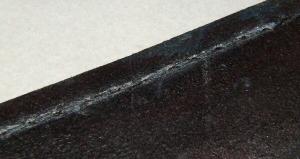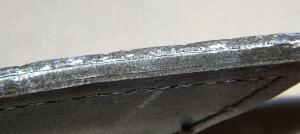-
Posts
5,940 -
Joined
Content Type
Profiles
Forums
Events
Blogs
Gallery
Everything posted by fredk
-
I dunno what do with that darned wabbit I have a number of skins I've picked up over the years. I sometimes put some out on my table at craft fairs and put small leather items on them. Seems a nice way to display the items
-
I would use a #0 or bastard cut file Thats quicker than 'sand' paper
-
6.2 mm to 5.55 mm is an easy reduction; less than 1 mm You can file the shank down by that much easily
-
I heard this one many years ago During WW2 an American Air Force unit was based in the English countryside. The Air Force personnel used to use the local pub One day an experienced Air Force man was with a new arrival. As they came to the pub one says 'These English yokels are so dumb. Wait till you see this' They approached two locals who were having a drink at a table The Airman put down a nickel and a dime and said 'Tell me which you think is worth more' One local looked at the two coins, scratched his head, then said 'Arr, now Oi thinks the bigger shinier coin be worth more' The Airmen laughed at this and walked on into the pub leaving the nickel and dime on the table The second local says to the first 'ere Henry, you know rightly that the dime is worth twice the nickel' 'Aye, I do that, but if I said so they'd stop playing this game' then he showed his friend a bucket under table 'so far I've made $30 this month playing this game with the US airmen'
-
Its a matter of semantics
-
Me too I just gently and easily skive away until it looks even
-
I seal the painted area and little bit around it
-
It certainly is strong. This scabbard was in regular use until it was returned to me a few years ago for the painting to be refreshed. No glue was used in its construction The secret is to make the thread coming from the back go through a long tunnel to get out the edge
-

Are rivets sufficient for light-duty belt loops?
fredk replied to DaleksInc's topic in Leatherwork Conversation
A few stitches would help -

Are rivets sufficient for light-duty belt loops?
fredk replied to DaleksInc's topic in Leatherwork Conversation
Then, can you use two rivets in each place? -

Are rivets sufficient for light-duty belt loops?
fredk replied to DaleksInc's topic in Leatherwork Conversation
They should hold. But what I've larnt is not to have the ends of the loop on the outside but cut a slot top & bottom and fit the loop through from the inside to the outside, then rivet. Any strain on the loop riveted on the outside puts all the strain on the rivet and it may pull out. Had it happen to me a lot until I changed the way I attach the loops Al Stohlman covers this in one of his books -
One style of sewing that I've not spotted anyone doing is the grain or flesh to edge In 2006 I was watching an episode of 'Time Team'. In a dig in Ely they uncovered an unusual knife sheath. Certain aspects of it confused the archaeologists, but we will skip over that. I decided to make a recreation of the knife scabbard. It would be smaller and decorated differently. This is what I made One of the things that confused the archaeologists was how it was put together with no sewing showing on the front. And I didn't want sewing on the front to ruin the stamped pattern. I knew the answer - grain to edge sewing A curved awl is used to pierce a hole from a place on the back to come out in the edge of the top piece. The sewing line and spacing is marked on the rear, which may be the grain or flesh side. Then at each sewing stop the curved awl is used to pierce a hole, with great care, then its saddle-stitched with two short curved needles I've tried to mark the stitching to show it This is the stitching on the rear; and along the edge, you can make out the back piece stitching in the lower part of the photo You don't need overly thick leather to do this. This scabbard is only 8mm thick (just over 1/4") I've only done this type of stitching a couple of times
-

Lets have a look at a "Genuine Leather" belt???
fredk replied to kgg's topic in Leatherwork Conversation
With the ex-factory, which was in Carrickfergus, 12 miles from Belfast, 'belts' were in various stages of completion. So by studying them I came to see how they were made -

Lets have a look at a "Genuine Leather" belt???
fredk replied to kgg's topic in Leatherwork Conversation
What I found with the 100 ex-factory belts was that it is all done by automatic machinery, in one continuous length. Cut to size length and holes punched I had one 'belt' that was about 10ft long. It was seemingly the tail end of a roll -
Here we are; 1 year completed (more or less) September 30 2024 Set #1, the car set - Pieces treated and kept on the top of the dash in the south facing windscreen (windshield) of a car 1. Baby Oil; Both sides are very dark, More flexible than Control 1 (C1), No smell, No sign of rot or fungus 2. Cooking Oil (rape seed); Both sides very dark, Slightly more flexible than C1, No smell, No sign of rot or fungus 3. Lard (pork fats); Light but darker than C2, Slightly more flexible than C1, No smell, No sign of rot or fungus 4. NFO Compound; Both sides very dark, Flex is better than C1, No smell, No sign of rot or fungus 5. Olive Oil ( Pure Extra Virgin); Both sides very dark, Flex is only slightly better than C1, Slight odd indistinct smell, No sign of rot or fungus 6. 3 in 1 oil (benzine); Both sides very dark, but back less so, Flex is stiffer than C1, No smell, No sign of rot or fungus 7. Vaseline; Very slightly darkened both sides, Flex is slightly stiffer than C1, No smell, No sign of rot or fungus Set #2 were hung outside on a wood frame. They got light and heavy rain with periods of sunshine, warm overcast and wind, both light breezes and strong winds The same oils were used in the same sequence . Control C1A was hung with the other pieces 1. Baby oil; Both sides are very dark, Flex is better than C1A, Slight smell of leather No sign of rot or fungus 2. Cooking oil; Both sides very dark, Flex is very slightly better than C1A, No smell, No sign of rot or fungus 3. Lard; Both sides slightly darker, Flex is about the same as C1A, No smell, No smell, No sign of rot or fungus 4. NFO Compound; Missing, blown away 5. Olive oil; Both sides and fairly dark, Flex is better than C1A, No smell, Grain surface feels oiled, No sign of rot or fungus 6. 3 in 1 oil; Both sides are now a very dark brown, Flex is better than C1A, No smell, No sign of rot or fungus 7. Vaseline; Both sides very slightly darkened, Flex is only very slightly better than C1A, No smell, No sign of rot or fungus None of the pieces seem to require re-oiling All but 1 test piece have a neutral smell, or none. That 1 piece, #5 of Set 1, the slight odd smell is so very faint and its not a bad smell therefore I'm not worried about it. #4 of Set 2 went AWOL just the day before I brought the pieces in to record them In conclusion; No rot or fungus. Just the loss of smell - either of leather or of the oil used. The darkening of the leather by some oils and greater flexibility by most I think thats it for now
-
yes it is. certain fluids used with leather and the tannens will leech out etching into the marble leaving an uneven working surface
-

different approach to tippmann tension
fredk replied to waynebergman's topic in Leather Sewing Machines
Hardly a 'best kept secret' but an under-used tool. Most of us have several in our tool drawers but rarely use them -
PVA glue going 'milky' means its trying to return to its glue state. If you use water-proof, or outside use, or weather-proof glue it won't be going 'milky' A mix for applying to leather edges lasts for as long as the glue stays liquid. Several hours, days if you keep it in an air-tight container If starts to get too thick just add a small bit of water. In fact slightly thick glue works best on edges. Treat it as you would your bottle of PVA glue
-
I just wet my leather before dyeing. Using a sponge to wet it thoroughly but not absolutely soaking
-

Lets have a look at a "Genuine Leather" belt???
fredk replied to kgg's topic in Leatherwork Conversation
Years ago I got a clearance lot of maybe 100 belts from a factory closure (no buckles). At the time I was making toy shields so I cut then up to make hand & arm straps on the shields -

Lets have a look at a "Genuine Leather" belt???
fredk replied to kgg's topic in Leatherwork Conversation
How long did it last him? My #1 got, at best, an average of 6 months from similar but not so good belts -
I had thoughts of you sewing lots of wee discs together to make a pouch, Then I wised up and realised, sew them up inside a pouch
-
You can pick up some really nice silk
-
I do it occasionally. I'd say use water-resistant or all-weather PVA glue. Then it won't become glue again at the slightest hint of water. The glue I get is thin enuf it doesn't need any more thinning but I put a small amount of acrylic floor finish (aka Pledge with Future shine or Mop and Glo or whatever its called now) in which helps the water proofing. It will work on chrome tan. ppl aren't putting it on right. You need to clamp up the chrome tan real tight and very close the join, like 1 mm from it. After applying the PVA you need to keep it clamped up until its fully dry. Its not a fast finish but its good for smoothing that awkward c/t edge In all cases I apply it with a #1 multi-purpose digit. I slick it with some beeswax when its dry




